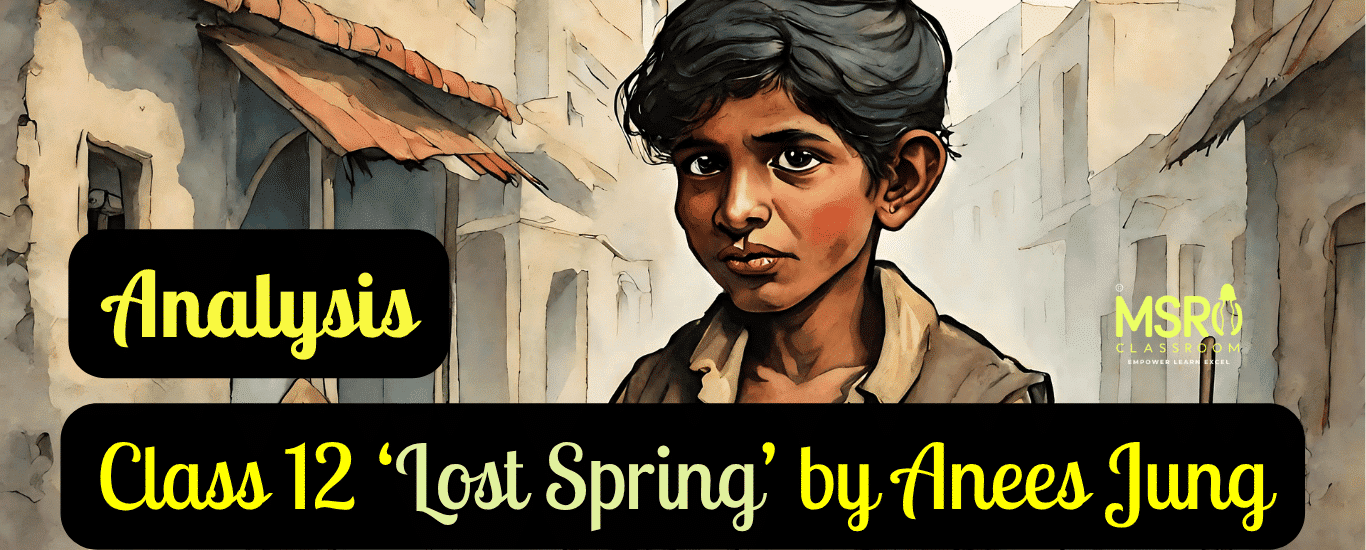Chapter 2 ‘Lost Spring’ by Anees Jung- Summary, Theme, Character Sketch, Textbook Questions and Extra Questions.
Chapter 2- Lost Spring Summary, Theme and Analysis
Table of Contents:
Next on Flamingo: Chapter 3- “Deep Water” by William Douglas
Summary ‘Lost Spring’ by Anees Jung:
- The excerpt from “Lost Spring: Stories of Stolen Childhood” by Anees Jung delves into the lives of impoverished children in India, mainly focusing on Saheb and Mukesh, whose childhoods are marred by poverty and exploitation.
- Saheb, a young boy in Seemapuri, scours garbage dumps for valuable items like coins, cherishing even the smallest finds. Despite promises of education, he remains entrenched in the cycle of poverty, eventually finding work at a tea stall and relinquishing his autonomy for a meagre wage.
- Mukesh, from Firozabad, dreams of becoming a motor mechanic amidst the backdrop of his family’s bangle-making profession. He represents the aspirations of children trapped in intergenerational poverty, yearning for a better life but often restricted by societal norms and economic circumstances.
- The excerpt illustrates the harsh realities faced by marginalised communities, where children like Saheb and Mukesh are born into predetermined destinies shaped by tradition, exploitation, and limited opportunities. Their dreams are tempered by the constraints of their environment, perpetuating cycles of poverty and hopelessness.

Theme ‘Lost Spring’ by Anees Jung:
Central Theme:
The central theme of “Lost Spring: Stories of Stolen Childhood” by Anees Jung revolves around the plight of street children forced into labour early in life and denied the opportunity of schooling.
The narrative sheds light on the harsh realities faced by children like Saheb and Mukesh, who are compelled to engage in menial jobs due to grinding poverty and societal indifference.
Through their stories, the author exposes the systemic issues that perpetuate child labour and inhibit access to education for marginalised communities.
Sub-theme:
The excerpt also highlights the callousness of society and the political class towards the suffering of the poor.
- Poverty and Exploitation: The excerpt vividly portrays the grinding poverty that forces children like Saheb and Mukesh into laborious jobs at a young age. Despite their dreams and aspirations, they are forced to work in hazardous conditions, such as rag-picking and glass-blowing, just to survive.
- Lack of Education: The absence of educational opportunities exacerbates the cycle of poverty and exploitation. Saheb expresses his willingness to attend school if one were available in his neighbourhood, indicating a desire for education among these children. However, the lack of schools further entrenches them in labour and deprivation.
- Broken Promises and Hopelessness: The protagonist’s promise to start a school for Saheb reflects the pervasive sense of hopelessness and broken promises in the lives of these children. Despite fleeting moments of optimism, such promises remain unfulfilled, highlighting the systemic neglect and indifference towards their plight.
- Tradition and Caste: The excerpt delves into the traditional occupations and caste dynamics that trap families like Mukesh’s into intergenerational cycles of poverty. The glass-blowing industry passed down through generations, perpetuates a cycle of exploitation and limited opportunities for upward mobility.
- Injustice and Apathy: The narrative highlights the indifference of society, including the political class, towards addressing the root causes of poverty and exploitation. Despite their struggles, street children and their families are marginalised and overlooked by those in positions of power.
Explanation of ‘Lost Spring’ for Auditory Learners:
Duration: 9 Minutes
Character Sketch ‘Lost Spring’:
Here are character sketches of the essential characters from the excerpt “Lost Spring” by Anees Jung:
- Saheb-e-Alam:
- Saheb-e-Alam is a young boy living in poverty in Seemapuri, a squatter settlement on the periphery of Delhi.
- He scrounges for gold in garbage dumps, highlighting his dire circumstances and the lengths he goes to survive.
- Saheb is depicted as hopeful and willing to learn, as evidenced by his willingness to attend school if one were available.
- Despite his hardships, Saheb retains a sense of innocence and wonder, particularly in his fascination with finding coins and watching others play tennis.
- Mukesh:
- Mukesh is a young boy from Firozabad, which is famous for its bangle-making industry.
- He dreams of becoming a motor mechanic, demonstrating a desire to break free from his family’s traditional occupation.
- Mukesh’s determination and ambition are evident in his willingness to walk a long distance to learn the trade of motor mechanics.
- Despite his aspirations, Mukesh is still a product of his environment, influenced by the poverty and limitations imposed by his family’s circumstances.
The characters from the excerpt collectively illustrate the themes of poverty, exploitation, resilience, and the pursuit of dreams amidst adversity portrayed in “Lost Spring.”
Textbook Questions/Answers “Lost Spring”:
Think As You Read:
| Q1: What is Saheb looking for in the garbage dumps? Where is he, and where has he come from? A1: Saheb is scavenging for valuable items, such as coins or notes, in the garbage dumps of the author’s neighbourhood. Saheb comes from Dhaka, Bangladesh, but now lives in Seemapuri, a place on the periphery of Delhi where many squatters from Bangladesh settled in 1971. Q2. What explanations does the author offer for the children not wearing footwear? A2: The author offers a few explanations for why children like Saheb do not wear footwear. Tradition: provides several. The author mentions that walking barefoot is considered a tradition rather than a result of poverty in some areas. Excuse for poverty: The author questions whether the tradition of walking barefoot is merely used as an excuse to justify the perpetual state of poverty in which these children live. Q3. Is Saheb happy working at the tea stall? Explain. A3: Saheb’s demeanour suggests a mixed sentiment about working at the tea stall. Initially, he seemed content and enthusiastic about the job, mentioning that he earns 800 rupees and receives all his meals. However, the author notices a change in his demeanour, indicating that Saheb’s initial happiness has diminished. The steel canister he carries seems to symbolise the burden of his new responsibilities, as he is no longer his master. Therefore, while Saheb may appreciate the job for providing him with some income and meals, it’s apparent that the weight of the job has taken a toll on his sense of freedom and contentment. Q4: What makes the city of Firozabad famous? A4: The city of Firozabad is famous for its bangles. It is the centre of India’s glass-blowing industry, where families have spent generations working around furnaces, welding glass, and making bangles for women. Q5: Mention the hazards of working in the glass bangles industry. A5: The hazards of working in the glass bangles industry include: Exposure to high temperatures: Children like Mukesh work in glass furnaces with high temperatures, which pose risks of burns and heat-related illnesses. Lack of ventilation: The dingy cells where they work often lack proper air and light, leading to respiratory problems and discomfort. Eye injuries: Working with glass can lead to eye injuries, and many children lose the brightness of their eyes due to prolonged exposure to glass dust and fumes. Long-term health issues: Constant exposure to hazardous conditions can lead to long-term health problems, including respiratory disorders, eye problems, and other occupational hazards. Q6: How is Mukesh’s attitude to his situation different from that of his family? A6: Mukesh’s attitude towards his situation differs from that of his family in that he dreams of becoming a motor mechanic and expresses a desire for independence and a different future. Despite the challenges and limitations imposed by his family’s circumstances and the societal norms of his community, Mukesh dares to dream of a different path for himself. He desires to learn and work in a garage, indicating a willingness to break away from the traditional occupation of bangle-making. While his family seems resigned to their fate and the limitations of their caste and economic status, Mukesh shows a spark of determination and ambition, albeit tempered by the reality of his surroundings. |
Understanding The Text:
Q1: What could be some of the reasons for the migration of people from villages to cities?
A1: There are several reasons for migrating people from villages to cities:
- Economic Opportunities: Cities often offer more job opportunities, especially in manufacturing, construction, services, and trade. People migrate in search of better-paying jobs to improve their economic conditions.
- Education: Cities usually have better educational facilities, including schools, colleges, and universities. Parents may migrate to cities to provide better educational opportunities for their children.
- Infrastructure and Amenities: Cities typically have better infrastructure, including healthcare facilities, transportation networks, and access to amenities like electricity, water, and sanitation. People migrate seeking access to these amenities and services.
- Escape from Poverty or Natural Disasters: Some people migrate from villages to cities to escape extreme poverty, drought, floods, or other natural disasters that make rural life difficult.
- Social Mobility: Cities often offer greater social mobility, allowing individuals from lower socioeconomic backgrounds to access opportunities for advancement and upward mobility.
Q2: Would you agree that promises made to poor children are rarely kept? Why do you think this happens in the incidents narrated in the text?
A2: Promises made to poor children in the text are rarely kept. This happens for various reasons:
- Systemic Inequality: The promises made to poor children reflect a desire to improve their lives, but systemic inequality and lack of resources often hinder the fulfilment of these promises.
- Limited Resources: Those making promises may genuinely intend to help, but they may need more resources, support, or means to follow through on their commitments.
- Structural Barriers: The structural barriers such as poverty, lack of education, and limited access to opportunities make it challenging to fulfil promises made to poor children.
- Institutional Failures: Institutions responsible for addressing poverty and providing education may need to be more effective or corrupt, further perpetuating the cycle of broken promises.
- Lack of Accountability: There may be a need for accountability among those making promises, leading to a disregard for the well-being and future of impoverished children.
Q3: What forces conspire to keep the workers in the bangle industry of Firozabad in poverty?
A3: Several forces contribute to keeping workers in the bangle industry of Firozabad in poverty:
- Exploitative Practices: The bangle industry often exploits child labour and pays low wages to workers, perpetuating poverty in the workforce.
- Lack of Regulation: The absence or weak enforcement of labour laws and regulations allows employers to exploit workers and keep wages low without facing consequences.
- Dependency on Middlemen: Workers in the bangle industry may depend on middlemen or contractors who control access to work and dictate terms of employment, further perpetuating poverty and exploitation.
- Caste-based Discrimination: The caste system may also contribute to the marginalisation and exploitation of certain communities, keeping them trapped in poverty and limiting their opportunities for socioeconomic advancement.
- Lack of Education and Skills: Limited access to education and vocational training opportunities restricts the ability of workers to seek alternative employment options, keeping them entrenched in the bangle industry and its cycle of poverty.
Talking About The Text:
Q1: How, in your opinion, can Mukesh realise his dream?
A1: Mukesh can realise his dream of becoming a motor mechanic through a combination of factors:
- Education: Mukesh should be provided with an education beyond the confines of his current environment. This might involve community outreach programs, NGOs, or governmental initiatives to ensure children like Mukesh have the opportunity to attend school.
- Vocational Training: Mukesh can benefit from vocational training programs focusing on skills like motor mechanics. These programs can equip him with the necessary knowledge and expertise to pursue his chosen career.
- Supportive Environment: Mukesh needs the support of his family, community, and society to pursue his dreams. This might involve financial assistance, mentorship, and encouragement to overcome his challenges.
- Advocacy and Awareness: Advocacy efforts to highlight the potential of children like Mukesh and raise awareness about the importance of providing opportunities for them can also contribute to realising his dream.
Q2: Mention the hazards of working in the glass bangles industry.
A2: Hazards of working in the glass bangles industry include:
- Health Risks: Working in environments with high temperatures and exposure to glass particles can lead to respiratory problems, eye injuries, and skin ailments.
- Physical Hazards: Children working in glass bangles are often exposed to hazardous working conditions such as cramped spaces, sharp tools, and heavy machinery, increasing the risk of accidents and injuries.
- Long-term Health Impacts: Prolonged exposure to the glass-making process can have long-term health implications, including respiratory diseases, vision impairment, and musculoskeletal disorders.
- Lack of Education: Children engaged in labour-intensive industries like glass bangles often miss out on education, limiting their future opportunities and perpetuating the cycle of poverty.
Q3: Why should child labour be eliminated and how?
A3: Child labour should be eliminated for several reasons:
- Protection of Rights: Child labour violates the fundamental rights of children to education, health, and a safe environment. Children have the right to enjoy their childhood free from exploitation and harm.
- Health and Safety: Child labour exposes children to hazardous working conditions that endanger their health and safety. Eliminating child labour ensures that children are not subjected to physical, emotional, or psychological harm in the workplace.
- Education and Development: Child labour deprives children of the opportunity to receive an education and develop their potential. Education is essential for breaking the cycle of poverty and empowering children to pursue better opportunities in the future.
- Social Justice: Eliminating child labour promotes social justice by ensuring all children have equal growth, development, and success opportunities. It helps create a more equitable society where every child has the chance to thrive and fulfil their potential.
Thinking About The Language:
Carefully read the following phrases and sentences taken from the text. Can you identify the literary device in each example?
1. Saheb-e-Alam which means the lord of the universe is directly in contrast to what Saheb is in reality.
2. Drowned in an air of desolation.
3. Seemapuri, a place on the periphery of Delhi yet miles away from it, metaphorically.
4. For the children it is wrapped in wonder; for the elders it is a means of survival.
5. As her hands move mechanically like the tongs of a machine, I wonder if she knows the sanctity of the bangles she helps make.
6. She still has bangles on her wrist, but not light in her eyes.
7. Few airplanes fly over Firozabad.
8. Web of poverty.
9. Scrounging for gold.
10. And survival in Seemapuri means rag-picking. Through the years, it has acquired the proportions of a fine art.
11. The steel canister seems heavier than the plastic bag he would carry so lightly over his shoulders.
Answers:
- Irony: Saheb-e-Alam means “lord of the universe,” a grand and majestic title. However, the irony lies in that Saheb, the character, lives in poverty and squalor, far from being a lord of anything.
- Metaphor: “Drowned in an air of desolation” describes the temple’s atmosphere. It suggests the temple is enveloped in a profound sense of emptiness and sadness, emphasising its desolate condition.
- Metaphor: Seemapuri being described as “a place on the periphery of Delhi yet miles away from it, metaphorically” employs metaphorical language to highlight the stark contrast between Seemapuri’s physical proximity to Delhi and its socio-economic distance from the city.
- Parallelism: This sentence draws a parallel between the perceptions of children and elders regarding garbage. It contrasts children’s sense of wonder with the practical necessity elders see in the garbage, emphasising their perspectives.
- Simile: “Her hands move mechanically like the tongs of a machine” uses a simile to compare the mechanical movement of the girl’s hands to the repetitive, automated action of a machine, highlighting the monotony and lack of agency in her work.
- Metaphor: “She still has bangles on her wrist, but not light in her eyes” is a metaphorical expression. It symbolises the loss of joy, hope, or vitality in the woman’s life despite the bangles on her wrist, traditionally symbolising happiness and auspiciousness.
- Hyperbole: “Few airplanes fly over Firozabad” employs hyperbole, an exaggeration, to emphasise the rarity of airplanes flying over Firozabad. It highlights the relatively remote and underdeveloped nature of the town.
- Metaphor: “Web of poverty” uses metaphor to describe poverty’s complex and entangled nature, likening it to a spider’s web that ensnares those caught within its grasp.
- Metaphor: “Scrounging for gold” metaphorically compares searching for valuable items in the garbage to searching for gold, highlighting the desperation and hope that drives individuals like Saheb to engage in such activities.
- Metaphor: “Survival in Seemapuri means rag-picking. Through the years, it has acquired the proportions of a fine art” metaphorically describes rag-picking as a form of survival that has been refined and perfected over time, likening it to the mastery of an artistic skill.
- Contrast: “The steel canister seems heavier than the plastic bag he would carry so lightly over his shoulders” The line contrast emphasises the weight difference between the steel canister and the plastic bag Saheb used to carry effortlessly. This highlights the increased burden and responsibility he now faces in his new job.
Things To Do:
The beauty of the glass bangles of Firozabad contrasts with the misery of the people who produce them.
This paradox is also found in some other situations, for example, those who work in gold and diamond mines, or carpet weaving factories, and the products of their labour, the lives of construction workers, and the buildings they build.
- Write a paragraph of about 200 to 250 words on any one of them. You can start by making notes.
Points to include in Note Making:
- Setting: Urban environment, characterised by towering skyscrapers and modern infrastructure.
- Paradox: Contrasts between the city’s skyline’s opulence and construction workers’ impoverished living conditions.
- Daytime labour: Construction workers toil tirelessly, contributing to constructing and developing the city’s buildings and infrastructure.
- Nighttime living conditions: Workers retreat to bleak labour camps on the city’s outskirts, where they reside in makeshift shelters.
- Physical labour: Workers engage in physically demanding tasks such as welding steel beams, pouring concrete, and operating heavy machinery.
- Disparity: The disparity between the workers’ contributions to the city’s development and their living standards highlights the paradox of progress.
- Symbolism: The skyscrapers symbolise progress and modernity, while the labour camps symbolise the hidden costs and inequalities of development.
Sample Paragraph:
| In the heart of the bustling metropolis, towering skyscrapers, symbols of modernity and progress, pierce the skyline. Yet, hidden beneath the glimmering facades lies a paradox that few care to acknowledge. Amidst the gleaming structures, construction workers labour tirelessly, their sweat and toil woven into the very fabric of the city’s landscape. By day, they scale dizzying heights, welding steel beams and pouring concrete, their hands calloused from the unforgiving work. However, as the sun sets and the city’s lights flicker to life, these workers fade into obscurity, banished to cramped labour camps on the outskirts of the urban sprawl. In the shadow of the skyscrapers they helped erect, they dwell in makeshift shelters devoid of comforts and luxuries enjoyed by those who inhabit the lofty heights above. Their lives stand in stark contrast to the luxury surrounding them, a testament to the inner city’s skyline’s opulence and construction workers’ impoverished living conditions, and their existence remains marginalised, their voices drowned out by the din of progress. It is a paradox that speaks volumes about the price of development, where the gleam of steel and glass belies the darkness that lurks in the shadows below. |









